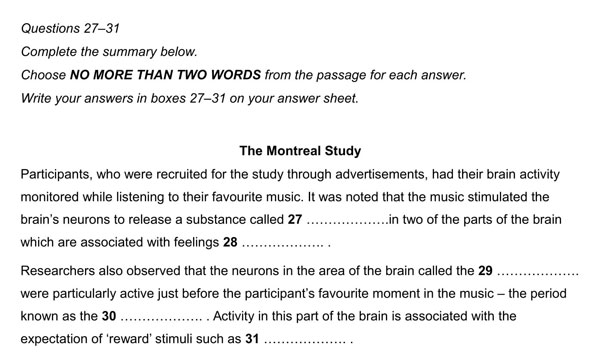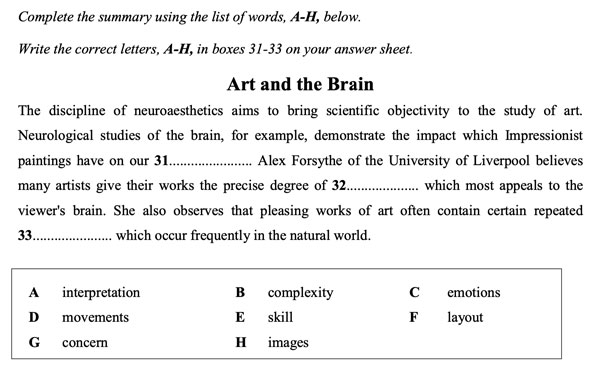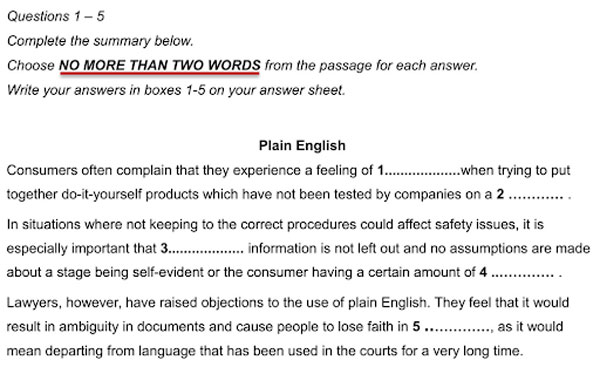IELTS Reading Summary Completion Questions
1. Introduction to Summary Completion Questions in IELTS Reading
In a Ielts reading summary completion question, you will be given a short summary of information from a part of the reading text with some gaps where words are missed out. What you have to do is to fill the gaps with appropriate words from the text.
However, a list of words will be sometimes given that requires you to choose the correct one to insert into the gaps, based on the content of the text. Also, there will be more words in the word box than necessary.

Especially, the summary will be definitely paraphrased or in the form of synonyms, hence, don’t expect the exact same words.
Through summary completion ielts reading, the examiners want to test your:
- skimming technique to understand the general meaning of the summary
- scanning technique to search for the correct information in the reading text
- ability to identify keywords, synonyms and paraphrases
- ability to make predictions using given context

This article will provide you with strategies together with common mistakes and tips to master the summary completion questions in IELTS Reading.
2. Summary Completion Strategies
2.1 Read the questions and requirements carefully
Candidates should first read the instructions and the summary completion questions cautiously before reading the text. Don’t forget the given word box if any.
You should attentively note the word limit (e.g. NO MORE THAN TWO WORDS)

2.2. Skim the summary and understand the general meaning
To get the overall meaning of the summary, skimming technique is requisite for candidates.
2.3. Re-read the summary in detail and Predict the answers
After having a general grasp of the summary, it is suggested to read in more detail and try to predict the answers in gaps by:
- Underlining the keywords to locate the information
- Identifying the part of speech of words needed (noun, verb, adjective, adverb, etc.) or verb tenses (present simple, past simple, etc.) or other criteria such as countable or uncountable nouns, etc.

If given a list of words, you can predict a gap with 2 to 3 options for saving time later. Notice the words or phrases collocating well with the words or phrases in the sentence containing the gap.
>> Read more: IELTS Reading Diagram Labelling Questions
2.4. Identify the related paragraph(s) in the reading text
Locating the paragraphs in the reading text that are associated with the summary will depend much on your scanning technique and understanding of the summary as well as the text will be mostly in the form of synonyms or paraphrases.
There may be more than 1 paragraph covering the content of the summary, so try to scan the information as carefully as possible.
2.5. Cross-check the information with the questions to fill in the gaps
You need to read the identified paragraph(s) in detail to make sure that you will find the correct answers. To do so, cross-checking the information that you’ve just read with the summary completion questions is essential. When the answers are found, note and fill in the gaps.
2.6. Double-check the answers
Maybe you have missed something that forces you to check the answers again after finding them.
You should check whether your answer is correct or not, as well as spelling, and grammatical mistakes.
3. Common Mistakes and Tips for Summary Completion Questions in IELTS Reading
| Common Mistakes | Tips |
| 1. Reading carefully the whole text before questions
This mistake is commonly made by so many test-takers, which squanders their time a lot for reading again after the questions. |
After acknowledging the topic of the passage, you should read the questions in the summary before locating the paragraphs to analyse |
| 2. Leaving blank answers
Instead of not answering a question, you can make a guess based on the context or the grammatical structures. |
You can get a point if your prediction is correct, so give an answer for any hesitation |
| 3. Looking for the exact same words or phrases in the reading text after reading the summary
In the IELTS Reading test, you hardly find an exact term from the summary to the text because the examiners aim to test your ability to use and identify synonyms or paraphrases. |
Think of synonyms or paraphrases when you are reading the summary in order to both understand the content of the summary and locate the answers more easily. |
| 4. Ignoring the spelling and grammatical rules when completing the gaps
Your answers should be correct in terms of meaning, grammar and spelling at the same time, so any misspelled or ungrammatical answers will be marked incorrect. |
Besides writing down the answers carefully into the answer sheet after each question, you also need to double-check your answers after completing the IELTS Reading test |
| 5. Being trapped by the examiner
A similar word in the given list of words (if any) may appear in the reading passage but it occasionally won’t be the answer. |
Focus more on the meaning of the questions when looking for the answer rather than finding the same words only. You should make use of synonyms or paraphrases instead of a matching word |

Other tips for Summary Completion Questions in IELTS Reading:
- Predicting the answers will help you with spotting the correct options.
- Don’t spend too much time on one question. Move to the next one if you can’t find the answer and note your hesitant choice for later. Use your time wisely with the easier ones first.
- The answers will be arranged in order of the questions, so the answer to the next question will be below the previous one.
- When the questions come together with a list of words, you can eliminate the options for a gap based on meaning or grammar.
Are you ready to apply these tips and strategies for Summary Completion Questions in IELTS Online Test immediately?
Install IELTS Test Pro now and practice IELTS Reading with us!